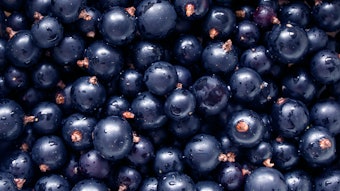Nearly all of the theoretical work and much of the practical work stydying flavor retention suggests that flavor retention increases as infeed solids content increases. The accepted theories on flavor retention note that flavors are lost during drying only until the drying droplet forms a semipermeable skin. It follows that the higher the initial solids content, the shorter the time until this semipermeable membrane is formed and the less volatile flavors are lost. This theory would appear to become invalid, however, during the encapsulation of artificial flavors (i.e., flavor chemicals constitute a significant fraction of the drying matrix) using very high infeed solids levels. One would expect to exceed the volubility limits of the encapsulating polymer (e.g., gum arabic) and therefore actually experience greater flavor losses during drying. Since one typically maintains a fixed ratio between carrier solids and flavor material (e.g., 80:20), if the carrier becomes insoluble, there actually is less polymer per unit flavor for encapsulation. Therefore, we address this relationship between infeed dryer solids and flavor retention during spray drying.
Materials and Methods
Three flavor encapsulating agents were used in this study: gum arabic, N-Lok (National Starch Corp.) and Maltrin M-1OO (Grain Processing Corp.). The Makrin and N-Lok were reconstituted (4fK)g solids plus the appropriate amount of water) with heating to 40, 45, 50, 55 and 60y0 solids one day prior to drying. Due to viscosity limitations, gum arabic was reconstituted only to 30,35,40,45 and 501% solids.
The day of spray drying, the flavor compounds were mixed in bulk and then individual batches weighed out for drying (100g). The flavor mixture was an equal weight of diacetyl, ethyl acetate, ethyl propionate, ethyl isobutyrate, ethyl butyrate, butyl acetate, ethyl vale rate, ethyl hexanoate, 2-heptanone, benzafdehyde, acetophenone, phenyl ethyl alcohol, benzyl acetate, methyl salicy late, L-carvone, methyl anthranilate, vanillin, isoeugenol, @-ionone and ethyl methyl phenyl glycidate.










